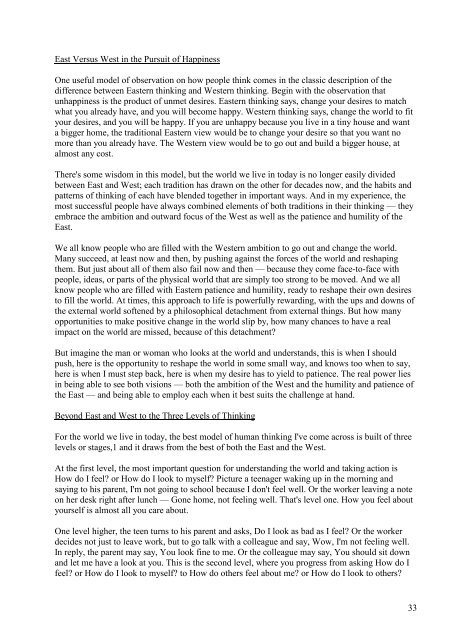How To Enhance Your Life - Dean Amory
Techniques for enhancing the quality of your life
Techniques for enhancing the quality of your life
Create successful ePaper yourself
Turn your PDF publications into a flip-book with our unique Google optimized e-Paper software.
East Versus West in the Pursuit of Happiness<br />
One useful model of observation on how people think comes in the classic description of the<br />
difference between Eastern thinking and Western thinking. Begin with the observation that<br />
unhappiness is the product of unmet desires. Eastern thinking says, change your desires to match<br />
what you already have, and you will become happy. Western thinking says, change the world to fit<br />
your desires, and you will be happy. If you are unhappy because you live in a tiny house and want<br />
a bigger home, the traditional Eastern view would be to change your desire so that you want no<br />
more than you already have. The Western view would be to go out and build a bigger house, at<br />
almost any cost.<br />
There's some wisdom in this model, but the world we live in today is no longer easily divided<br />
between East and West; each tradition has drawn on the other for decades now, and the habits and<br />
patterns of thinking of each have blended together in important ways. And in my experience, the<br />
most successful people have always combined elements of both traditions in their thinking — they<br />
embrace the ambition and outward focus of the West as well as the patience and humility of the<br />
East.<br />
We all know people who are filled with the Western ambition to go out and change the world.<br />
Many succeed, at least now and then, by pushing against the forces of the world and reshaping<br />
them. But just about all of them also fail now and then — because they come face-to-face with<br />
people, ideas, or parts of the physical world that are simply too strong to be moved. And we all<br />
know people who are filled with Eastern patience and humility, ready to reshape their own desires<br />
to fill the world. At times, this approach to life is powerfully rewarding, with the ups and downs of<br />
the external world softened by a philosophical detachment from external things. But how many<br />
opportunities to make positive change in the world slip by, how many chances to have a real<br />
impact on the world are missed, because of this detachment?<br />
But imagine the man or woman who looks at the world and understands, this is when I should<br />
push, here is the opportunity to reshape the world in some small way, and knows too when to say,<br />
here is when I must step back, here is when my desire has to yield to patience. The real power lies<br />
in being able to see both visions — both the ambition of the West and the humility and patience of<br />
the East — and being able to employ each when it best suits the challenge at hand.<br />
Beyond East and West to the Three Levels of Thinking<br />
For the world we live in today, the best model of human thinking I've come across is built of three<br />
levels or stages,1 and it draws from the best of both the East and the West.<br />
At the first level, the most important question for understanding the world and taking action is<br />
<strong>How</strong> do I feel? or <strong>How</strong> do I look to myself? Picture a teenager waking up in the morning and<br />
saying to his parent, I'm not going to school because I don't feel well. Or the worker leaving a note<br />
on her desk right after lunch — Gone home, not feeling well. That's level one. <strong>How</strong> you feel about<br />
yourself is almost all you care about.<br />
One level higher, the teen turns to his parent and asks, Do I look as bad as I feel? Or the worker<br />
decides not just to leave work, but to go talk with a colleague and say, Wow, I'm not feeling well.<br />
In reply, the parent may say, You look fine to me. Or the colleague may say, You should sit down<br />
and let me have a look at you. This is the second level, where you progress from asking <strong>How</strong> do I<br />
feel? or <strong>How</strong> do I look to myself? to <strong>How</strong> do others feel about me? or <strong>How</strong> do I look to others?<br />
33


















